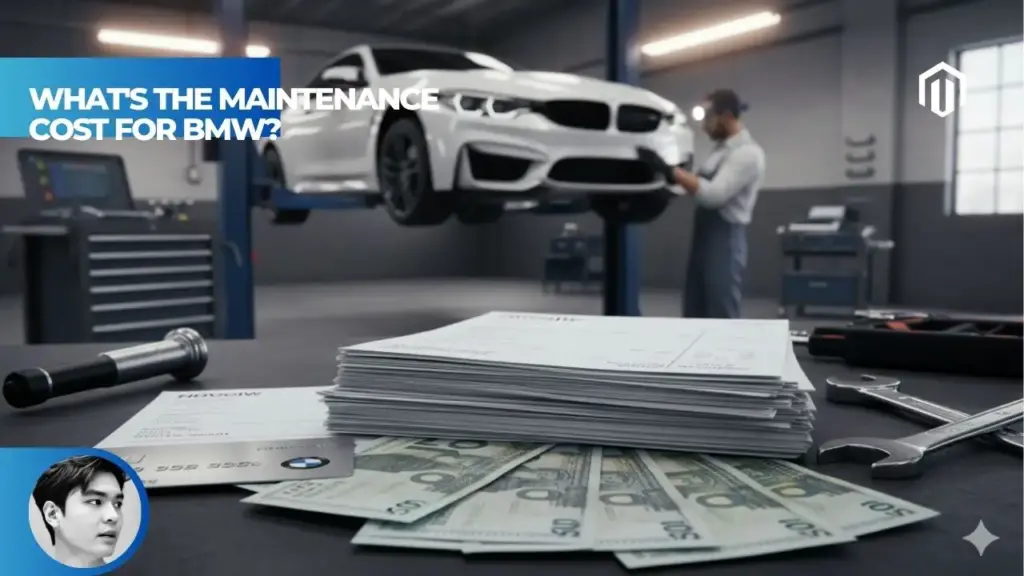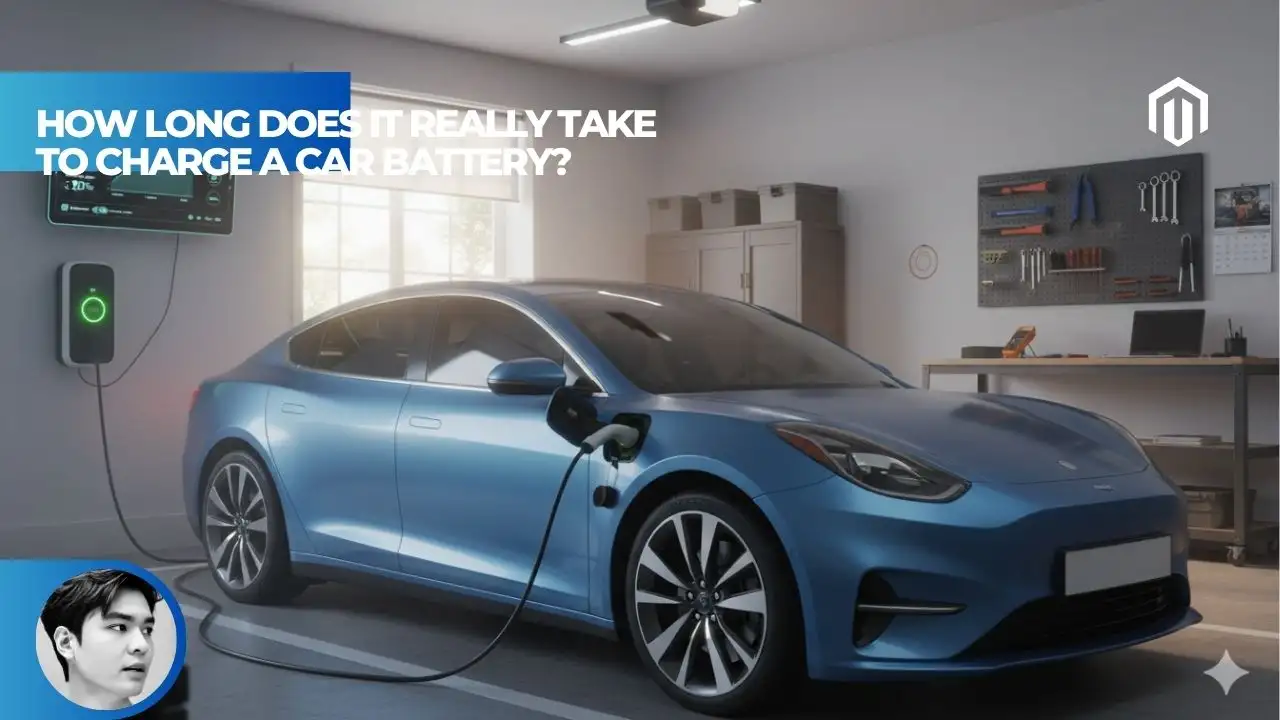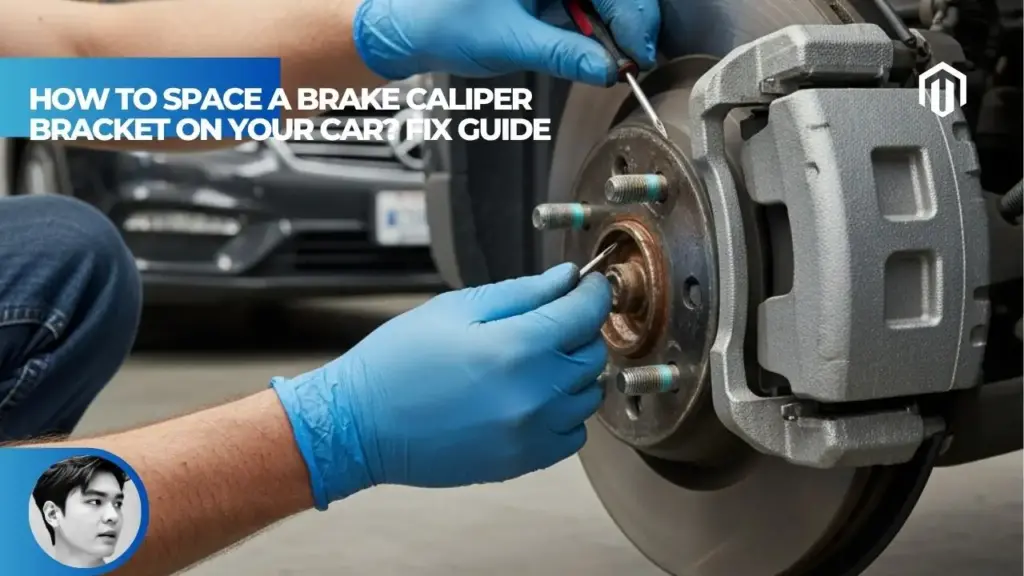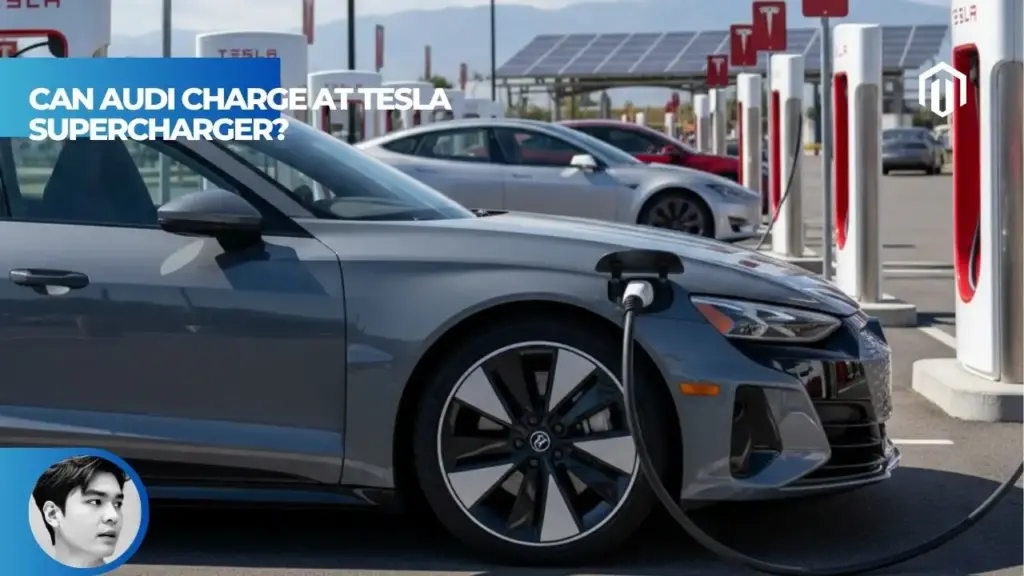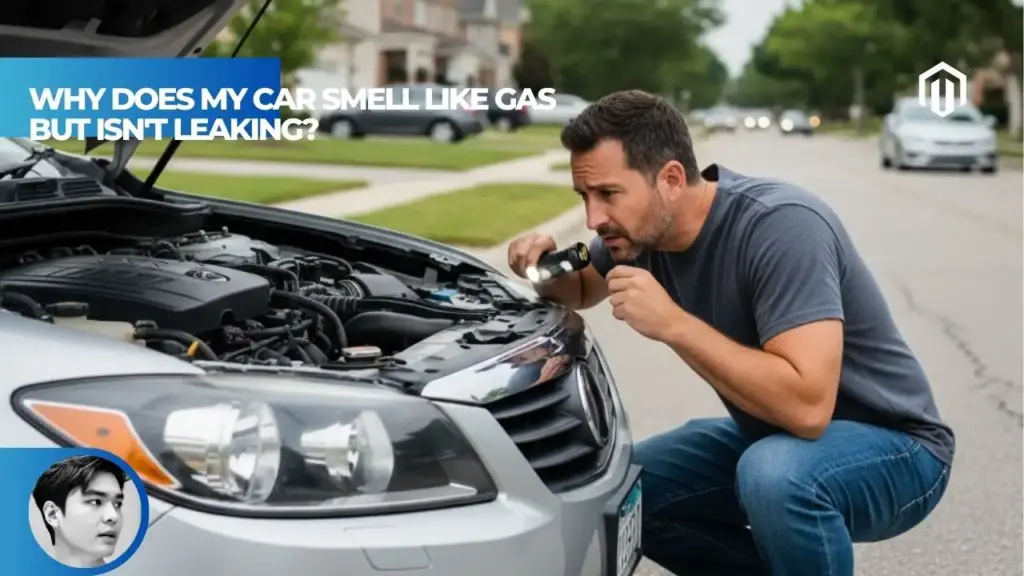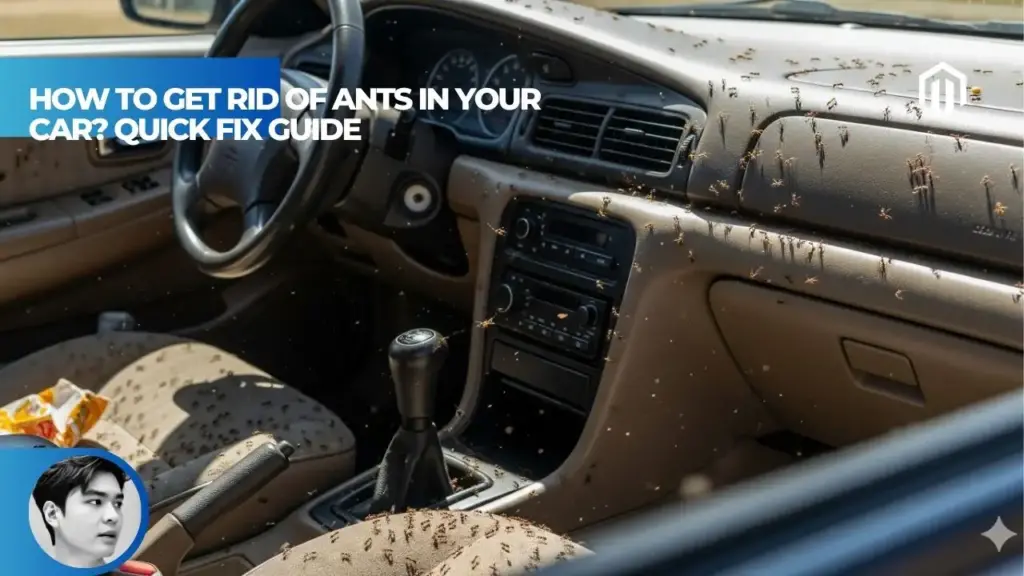You may also like:
- 【Explained】What Mileage Do BMW Start to Break Down? High-Mileage Costs and Lifespan
- 【Explained】What Is More Expensive: BMW or Mercedes? (Cost of Ownership)
- 【Explained】What Is More Reliable: BMW or Mercedes? (Repair Costs)
- 【Explained】How Many Miles Is Good for a Used Car? (Why Maintenance Matters More)
- 【Explained】How Many Miles Can Audi Last? Factors Affecting Lifespan and Reliability
BMW maintenance costs average $15,991-$17,800 over 10 years, with annual expenses ranging from $968-$1,200 during the warranty period and escalating to $1,500-$2,500 after the complimentary BMW Ultimate Care coverage expires at 3 years/36,000 miles. New BMW owners benefit from zero maintenance costs during the first three years thanks to included coverage, but should budget aggressively for years 4-10 when repair probabilities increase from 15% to 47%[1].
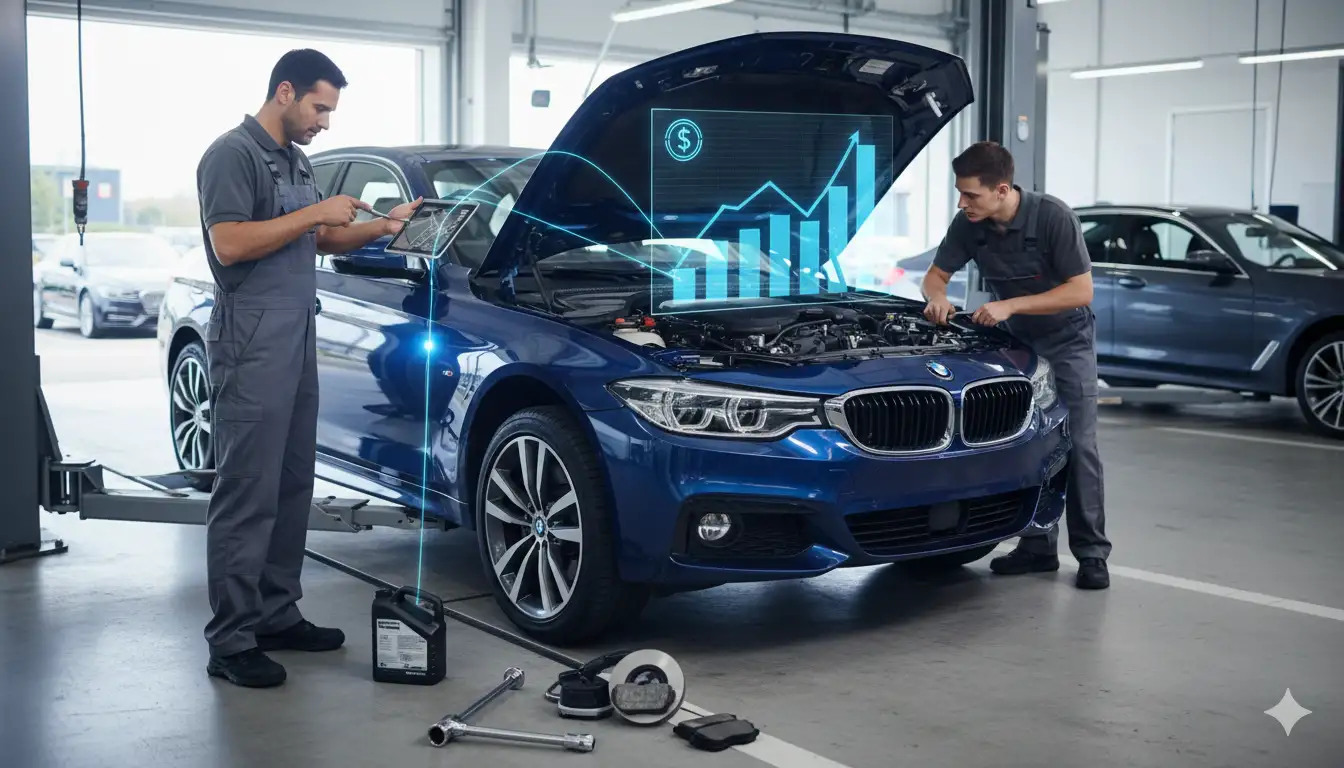
Average Annual BMW Maintenance Cost Overview
Understanding BMW maintenance costs requires examining both short-term and long-term ownership expenses. According to Autvex’s analysis of luxury vehicle ownership data, BMW maintenance costs position the brand squarely in the middle of German luxury competitors, though significantly above mainstream brands.
BMW Maintenance Cost Over 10 Years
The 10-year total maintenance cost for BMW vehicles averages $15,991, placing it $4,007 above the luxury segment average. This figure encompasses both scheduled maintenance and unexpected repairs, with costs accelerating dramatically after year five when major components begin requiring attention[1].
Year-by-year breakdown reveals an escalating pattern:
| Year | Annual Cost | Major Repair Probability |
|---|---|---|
| 1 | $686 | 4.66% |
| 2 | $784 | 7.66% |
| 3 | $973 | 8.67% |
| 4 | $1,226 | 15.36% |
| 5 | $1,467 | 22.02% |
| 6 | $1,903 | 24.89% |
| 7 | $2,101 | 26.71% |
| 8 | $2,197 | 35.23% |
| 9 | $2,285 | 38.18% |
| 10 | $2,369 | 47.11% |
The probability of requiring a major repair increases to 47.11% by year 10, nearly one in two vehicles needing significant work.
BMW Repair Costs Over 5 Years
During the first five years, BMW owners spend approximately $5,136 on maintenance and repairs, with costs relatively controlled during the warranty period. The first three years benefit from BMW Ultimate Care coverage, keeping out-of-pocket expenses minimal[2].
Years 4-5 mark the transition period where:
- Warranty coverage expires
- Wear items require replacement
- Minor repairs become more frequent
- Annual costs jump from $973 to $1,467
BMW Maintenance Budget Yearly
RepairPal data indicates BMW owners should budget $968 annually for routine maintenance, though this varies significantly by model and age. Compared to the $652 industry average, BMWs cost approximately 48% more to maintain than typical vehicles[3].
Realistic annual budgeting should consider:
- Years 1-3: $0 (Ultimate Care coverage)
- Years 4-6: $1,500-$2,000
- Years 7-10: $2,100-$2,400
- Post-10 years: $2,500+
Is BMW the Most Expensive Car to Maintain
BMW ranks third among German luxury brands for maintenance costs, making it expensive but not the priciest. Annual maintenance comparisons reveal[2]:
- Land Rover: $1,173
- Jaguar: $1,123
- Audi: $987
- BMW: $968
- Mercedes-Benz: $908
- Lexus: $551
While BMW exceeds Mercedes-Benz by only $60 annually, both German brands significantly surpass Japanese luxury competitors like Lexus.
BMW Maintenance Cost by Model and Variables
Different BMW models exhibit substantial maintenance cost variations based on complexity, performance level, and component specifications.
BMW Maintenance Cost by Model (3 Series, X5)
Model-specific maintenance costs demonstrate clear patterns, with [entry-level models] proving more affordable than SUVs and performance variants[3]:
| BMW Model | Annual Maintenance Cost |
|---|---|
| 330i | $748 |
| 528i | $825 |
| X3 | $1,034 |
| M3 | $1,161 |
| X5 | $1,166 |
| M5 | $1,173 |
The 3 Series remains BMW’s most economical model to maintain, while X5 and M Series vehicles command premium maintenance costs.
Maintenance Cost for Used BMW vs New
Used BMW maintenance costs escalate significantly compared to new models with active coverage. When evaluating used BMWs, consider that vehicles beyond the Ultimate Care period face immediate maintenance expenses[4].
Cost differentials include:
- New BMWs: $0 for 3 years/36,000 miles
- 4-6 year old BMWs: $1,500-$2,000 annually
- 7-10 year old BMWs: $2,100-$2,400 annually
- 10+ year old BMWs: $2,500+ annually
High Mileage BMW Maintenance Issues
High-mileage BMWs present unique challenges, with repair probability exceeding 70% after 100,000 miles. Common high-mileage issues requiring expensive repairs include:
- Water pump failure: $1,200-$1,800
- Ignition coil replacement: $800-$1,200
- Window regulator failure: $400-$600 per window
- Valve cover gasket: $1,000-$1,500
- Turbocharger replacement: $2,500-$4,000
BMW M-Series Maintenance Expense
M Series vehicles represent BMW’s performance pinnacle but carry premium maintenance costs averaging $1,161-$1,173 annually. Specialized components and aggressive driving characteristics accelerate wear[5].
M-specific maintenance considerations:
- DCT transmission service: $600-$1,000 every 50,000 miles
- Carbon ceramic brakes: $5,000-$8,000 per axle
- Performance tires: $1,500-$2,500 every 15,000-20,000 miles
- Differential fluid: $300-$500 every 30,000 miles
BMW N54 Engine Maintenance Costs
The twin-turbocharged N54 engine, found in 2007-2013 models, notoriously requires extensive maintenance beyond 60,000 miles. Common N54 issues include:
- High-pressure fuel pump: $1,000-$1,500
- Fuel injectors: $2,000-$3,000 (set of 6)
- Turbocharger wastegate: $1,500-$2,500
- Valve cleaning: $800-$1,200
Annual N54 maintenance typically ranges $2,000-$3,000 for high-mileage examples.
Cost of Ownership BMW vs Competitors
BMW’s position within the luxury segment reveals nuanced ownership cost dynamics compared to direct competitors.
Cost of Ownership BMW vs Mercedes
BMW and Mercedes-Benz maintain nearly identical maintenance costs, with BMW averaging $968 versus Mercedes’ $908 annually—a mere $60 difference. However, total ownership costs diverge based on specific factors[2]:
| Factor | BMW | Mercedes-Benz |
|---|---|---|
| Annual Maintenance | $968 | $908 |
| Major Repair Risk (10yr) | 47.11% | 43.87% |
| Depreciation (5yr) | 49% | 52% |
| Insurance Premium | $2,280 | $2,410 |
Is BMW More Expensive to Maintain Than Audi or Mercedes-Benz
Comparing German luxury brands reveals BMW occupies the middle position. When comparing specific models, maintenance hierarchies shift based on vehicle class[3]:
Annual maintenance comparison:
- Audi: $987 (highest)
- BMW: $968 (middle)
- Mercedes: $908 (lowest)
Despite Audi’s higher average, individual model comparisons vary significantly. Audi’s Quattro all-wheel-drive systems add complexity and cost compared to BMW’s rear-wheel-drive models.
True Cost to Own BMW
According to Autvex research, the 5-year true cost to own extends beyond maintenance to encompass:
- Depreciation: $35,000-$45,000 (largest expense)
- Insurance: $11,400 average
- Fuel: $9,500 (premium required)
- Maintenance/Repairs: $5,136
- Total 5-year cost: $61,036-$71,036
This positions BMW ownership at approximately $1,017-$1,184 monthly over five years, excluding loan interest.
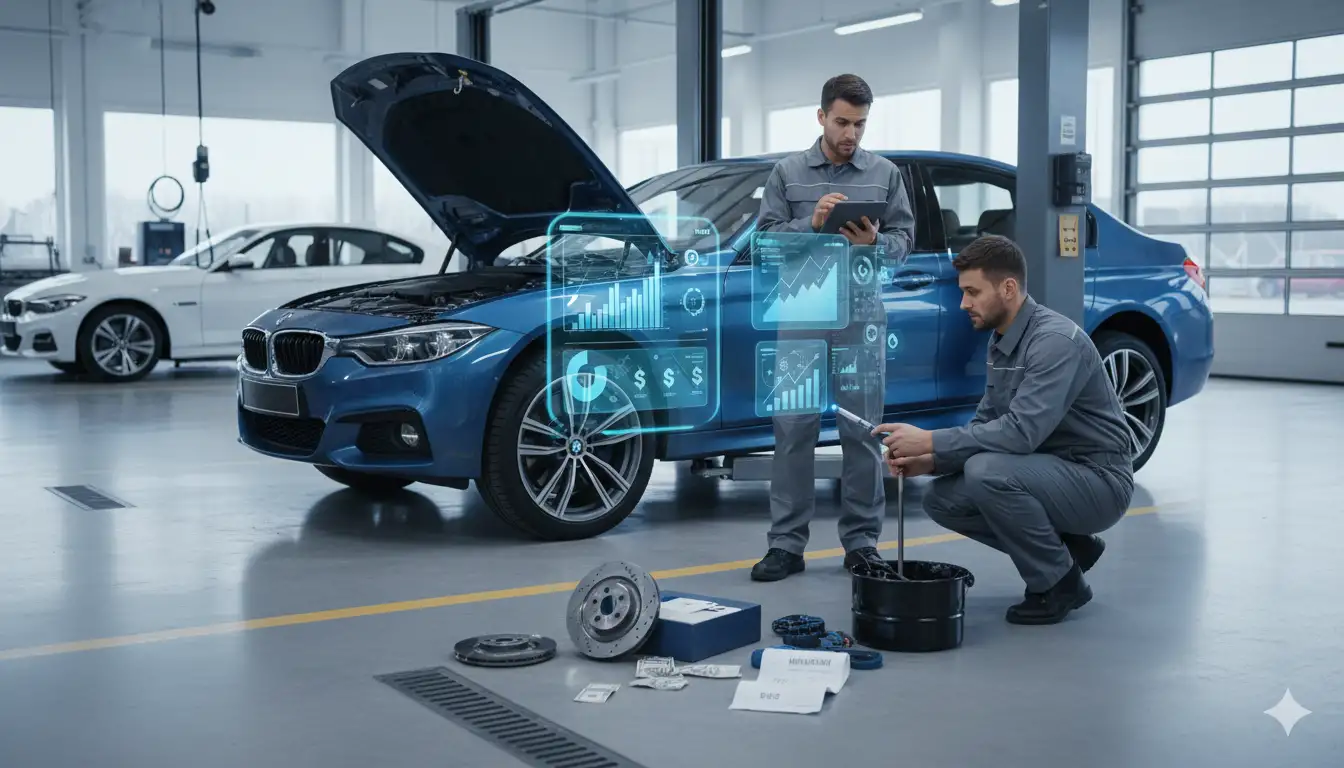
BMW Ultimate Care and Warranty Programs
BMW’s included maintenance programs significantly impact early ownership costs, providing substantial value during the critical first years.
BMW Ultimate Care Cost and Coverage
BMW Ultimate Care comes standard at no additional cost on all new BMWs, covering scheduled maintenance for 3 years/36,000 miles. The program’s retail value approximates $1,500-$2,000 if services were purchased separately[6].
Coverage includes:
- Engine oil and filter changes
- Brake fluid flush
- Engine air filter replacement
- Spark plug replacement
- Cabin microfilter replacement
- Remote battery replacement
- Vehicle inspections
BMW Included Maintenance Period (3 Years/36k Miles)
The 3-year/36,000-mile coverage represents industry-leading maintenance inclusion, though previous programs offered more generous terms:
- 2017+ models: 3 years/36,000 miles (Ultimate Care)
- 2015-2016 models: 4 years/50,000 miles (Ultimate Service)
- Pre-2015: Pay-per-service model
This coverage eliminates approximately $2,500 in maintenance costs during the typical lease period.
BMW Extended Maintenance Plan Price
BMW Ultimate Care+ extends maintenance coverage up to 7 years/125,000 miles for additional cost. Pricing varies by model but typically ranges[7]:
- 4-year extension: $800-$1,200
- 5-year extension: $1,500-$2,000
- 7-year maximum: $2,500-$5,249
The extended coverage adds brake pads, wiper blades, and clutch replacement to standard Ultimate Care services.
BMW Extended Warranty Cost
Vehicle Service Contracts (VSC) extend mechanical coverage beyond the factory warranty up to 7 years/100,000 miles. Pricing depends on coverage level:
| Coverage Level | Deductible | Approximate Cost |
|---|---|---|
| Platinum | $0 | $3,500-$4,500 |
| Gold | $50 | $2,800-$3,800 |
| Silver | $100 | $2,200-$3,200 |
Cost of BMW Oil Services Package
The BMW Ultimate Care Oil Services plan offers unlimited oil changes for 3 years at $249, exclusively for vehicles exceeding 60 months/60,000 miles without active coverage[8].
This represents exceptional value considering:
- Single oil change cost: $150-$200
- Break-even point: 2 services
- Typical requirement: 4-6 changes over 3 years
- Savings potential: $350-$950
Specific BMW Service and Repair Prices
Understanding individual service costs helps budget for post-warranty ownership expenses.
Cost of BMW Oil Change Dealership
BMW oil changes at dealerships typically cost $150-$200, reflecting synthetic oil requirements and comprehensive multi-point inspections. Independent shops charge $90-$130 for comparable service[4].
Oil change specifics:
- Oil capacity: 5-8 quarts depending on engine
- Oil type: BMW-approved 0W-30 or 5W-30 synthetic
- Filter: OEM specification required
- Labor: 0.5-1.0 hour
- Inspection: 30-point vehicle check included
BMW Brake Pad Replacement Cost
Brake pad replacement varies significantly between standard and performance models. Dealership pricing typically ranges $300-$700 per axle, with M Series ceramic brakes reaching $1,500 per axle[5].
Brake service cost factors:
- Standard brakes: $300-$500 per axle
- M Sport brakes: $500-$700 per axle
- Carbon ceramic: $1,200-$1,500 per axle
- Rotor replacement: Add $400-$800 per axle
- Brake fluid flush: $150-$200
Price for Major BMW Service Interval
Major services occur at specific mileage intervals, with costs escalating based on required components:
| Service Interval | Typical Cost | Services Included |
|---|---|---|
| 30,000 miles | $400-$600 | Oil, filters, brake fluid |
| 60,000 miles | $800-$1,200 | Above plus spark plugs, transmission service |
| 90,000 miles | $1,200-$1,800 | Above plus coolant, differential service |
BMW Tire Replacement Cost Run Flats
BMW’s standard run-flat tires cost $250-$400 per tire, significantly exceeding conventional tire prices. Complete set replacement typically totals $1,200-$2,000 including mounting and balancing[3].
Run-flat considerations:
- Limited repair options after puncture
- Reduced tread life (20,000-30,000 miles)
- Harsh ride quality
- Limited brand selection
- Cannot mix with conventional tires
Common BMW Repair Costs (Water Pump, Coils)
Frequent BMW repairs demonstrate consistent pricing patterns across models. Understanding these helps anticipate future expenses[1]:
| Common Repair | Cost Range | Failure Mileage |
|---|---|---|
| Water pump | $1,200-$1,800 | 60,000-100,000 |
| Ignition coils | $800-$1,200 | 40,000-80,000 |
| Window regulator | $400-$600 | 50,000-100,000 |
| Valve cover gasket | $1,000-$1,500 | 60,000-90,000 |
| Thermostat | $500-$800 | 80,000-120,000 |
DIY vs Dealer Maintenance Costs BMW
Choosing between dealership and independent service significantly impacts long-term ownership costs.
Cost Difference Independent Shop vs BMW Dealer
Independent BMW specialists typically charge 30-40% less than dealerships while maintaining comparable quality. According to Autvex’s service cost analysis, typical savings include[2]:
| Service | Dealership | Independent | Savings |
|---|---|---|---|
| Oil change | $180 | $120 | 33% |
| Brake pads | $600 | $400 | 33% |
| Water pump | $1,500 | $1,000 | 33% |
| Annual service | $1,500 | $1,000 | 33% |
Annual savings using independent shops: $400-$800
Is It Cheaper to Service a BMW at an Independent Mechanic or the Dealership
Independent mechanics offer substantial savings, but considerations extend beyond price. Similar to Audi service options, BMW owners must weigh multiple factors[4]:
Dealership advantages:
- Factory-trained technicians
- Latest technical bulletins
- Genuine BMW parts
- Warranty preservation
- Loaner vehicles
- Complete service records
Independent shop advantages:
- 30-40% cost savings
- Flexible scheduling
- Personal relationships
- Aftermarket part options
- Specialized expertise on older models
For vehicles under warranty, dealership service maintains coverage integrity. Post-warranty vehicles benefit most from independent specialist care.
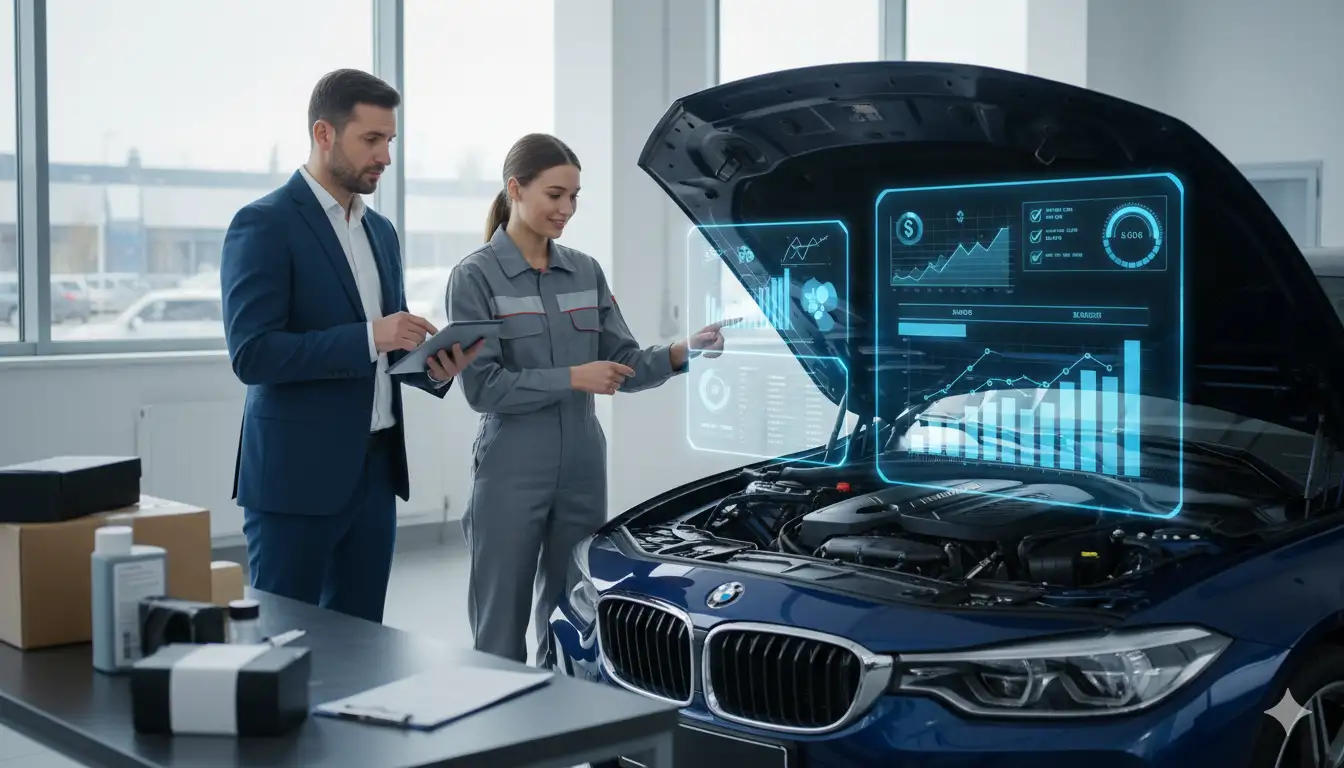
Key Takeaways
- First 3 years cost $0 thanks to BMW Ultimate Care coverage
- 10-year total averages $15,991, significantly above luxury segment average
- Annual costs escalate from $686 to $2,369 over 10 years
- 47% probability of major repair by year 10
- Independent shops save 30-40% versus dealership pricing
- M Series costs 20% more than standard models annually
- Extended warranty worth considering after year 4
Decision Path / Next Steps
- For Prospective BMW Buyers: Factor $1,500-$2,500 annual maintenance into ownership budgets after year 3. Consider certified pre-owned vehicles with remaining Ultimate Care coverage. Evaluate Ultimate Care+ extended maintenance at purchase—it’s cheaper than buying later. Research BMW reliability at different mileages to anticipate major service points.
- For Current BMW Owners (Years 1-3): Maximize Ultimate Care benefits by adhering to service schedules. Begin researching independent BMW specialists for post-warranty service. Consider Ultimate Care+ extension before coverage expires. Start a maintenance fund targeting $150 monthly for future expenses.
- For Out-of-Warranty BMW Owners: Identify reputable independent BMW specialists offering 30-40% savings. Prioritize preventive maintenance to avoid costly repairs. Consider the $249 Ultimate Care Oil Services for vehicles over 60,000 miles. Evaluate selling before major service intervals if repair costs exceed vehicle value.
- For High-Mileage BMW Owners: Budget $2,500+ annually for maintenance and repairs. Address known issues proactively (water pumps, coils, gaskets). Consider DIY maintenance for simple tasks like air filters and brake pads. Evaluate whether continued ownership makes financial sense versus newer alternatives with warranty coverage.
FAQs
What is the average yearly maintenance cost for a BMW?
The average annual maintenance cost is $968-$1,200, increasing to $1,500-$2,500 after the warranty expires, with costs accelerating as the vehicle ages.
Is it true that BMW maintenance is free for the first few years?
Yes, BMW Ultimate Care covers scheduled maintenance for 3 years/36,000 miles on 2017+ models, with 2015-2016 models receiving 4 years/50,000 miles coverage.
How much should I budget for BMW maintenance after the warranty expires?
Budget $1,500-$2,500 annually after year 3, with costs potentially reaching $2,800+ per year for vehicles over 6 years old.
Is BMW more expensive to maintain than Audi or Mercedes-Benz?
BMW averages $968/year versus Mercedes at $908/year and Audi at $987/year, making BMW slightly more expensive than Mercedes but less than Audi.
What are the most common expensive repairs on older BMW models?
Water pumps ($1,200-$1,800), ignition coils ($800-$1,200), window regulators ($400-$600), and valve cover gaskets ($1,000-$1,500) are common expensive repairs.
How much does a brake job cost on a BMW 3 Series?
BMW brake pad replacement typically costs $300-$700 per axle at dealerships, with independent shops charging 30-40% less.
Is it cheaper to service a BMW at an independent mechanic or the dealership?
Independent BMW specialists typically charge 30-40% less than dealerships while maintaining quality, making them significantly more cost-effective for out-of-warranty vehicles.
What does the BMW Ultimate Care package include and is it worth the price?
Ultimate Care covers oil changes, filters, brake fluid, and inspections for 3 years/36,000 miles free on new BMWs, worth approximately $1,500-$2,000 in services.
How much does a BMW 5-Series cost to maintain over 10 years?
BMW 5-Series maintenance averages $13,000-$18,000 over 10 years, depending on model year, driving conditions, and whether performance variants are involved.
References
- CarEdge. (2025). BMW Maintenance Schedule and Costs. https://caredge.com/bmw/maintenance
- RepairPal. (2025). BMW Maintenance Cost Guide. https://www.marketwatch.com/insurance-services/car-warranty/bmw-maintenance-cost/
- Automoblog. (2025). BMW Maintenance Cost: What You Might Pay. https://www.automoblog.com/reviews/maintenance/bmw-maintenance-cost/
- Loubachridt BMW. (2024). BMW Maintenance: What Every Owner Should Know. https://www.loubachrodtbmw.com/blogs/2288/uncategorized/bmw-maintenance/
- M List Company. (2025). 5 Hidden Costs of Owning a BMW M Car. https://mlistco.com/blog/5-hidden-costs-of-owning-a-bmw-m-car-that-no-one-tells-you-about
- BMW USA. (2025). BMW Service and Warranty Book. https://www.bmwusa.com/explore/bmw-value/bmw-ultimate-service/service-and-warranty-books.html
- Fields BMW Lakeland. (2025). What is Included in the BMW Ultimate Care+ Program. https://www.fieldsbmwlakeland.com/blog/2025/february/10/what-is-included-in-the-bmw-ultimate-care-program.htm
- BMW USA Service. (2025). BMW Maintenance Plans. https://bmwusaservice.com/ultimatecare

I am a senior automotive analyst at Autvex. Expert vehicle evaluations, in-depth reviews, and objective analysis helping readers make informed automotive decisions with years of industry experience.

